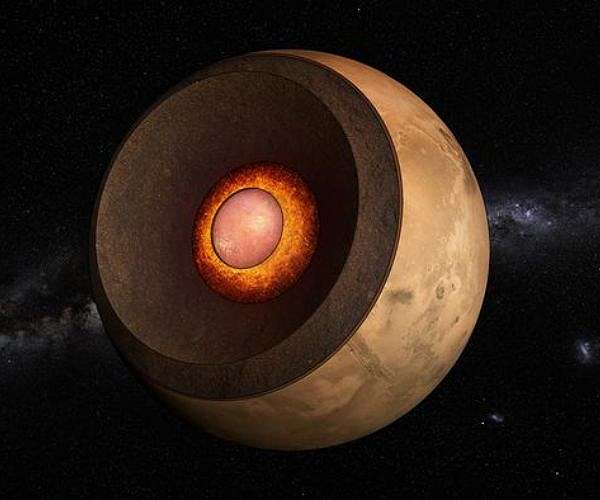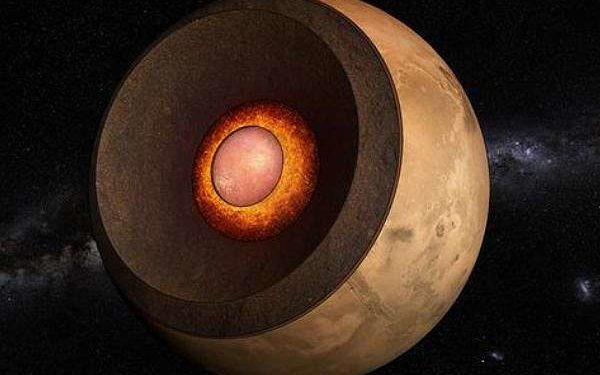
Mystery of the Martian core solved
by by Barbara Vonarburg
Zurich, Switzerland (SPX) Oct 26, 2023
For four years, NASA’s InSight lander recorded tremors on Mars with its seismometer. Researchers at ETH Zurich collected and analysed the data transmitted to Earth to determine the planet’s internal structure. “Although the mission ended in December 2022, we’ve now discovered something very interesting,” says Amir Khan, a Senior Scientist in the Department of Earth Sciences at ETH Zurich.
An analysis of recorded marsquakes, combined with computer simulations, paint a new picture of the planet’s interior. Sandwiched between Mars’s liquid iron alloy core and its solid silicate mantle lies a layer of liquid silicate (magma) about 150 kilometres thick. “Earth doesn’t have a completely molten silicate layer like that,” Khan says.
This finding, now published in the scientific journal Nature alongside a study led by Henri Samuel, Institut de Physique de Globe de Paris, that reaches a similar conclusion using complimentary methods, also provides new information on the size and composition of Mars’ core, resolving a mystery that researchers have until now been unable to explain.
An analysis of the initially observed marsquakes had shown that the average density of the Martian core had to be significantly lower than that of pure liquid iron. The Earth’s core, for example, consists of about 90 percent iron by weight. Light elements such as sulphur, carbon, oxygen, and hydrogen make up a combined total of around 10 percent by weight. Initial estimates of the density of the Martian core showed that it is comprised of a much larger share of light elements – around 20 percent by weight. “This represents a very large complement of light elements, bordering on the impossible. We have been wondering about this result ever since,” says Dongyang Huang, a postdoctoral researcher in the Department of Earth Sciences at ETH Zurich.
Fewer light elements
The new observations show that the radius of the Martian core has decreased from the initially determined range of 1,800-1,850 kilometres to somewhere in the range of 1,650- 1,700 kilometres, which is about 50 percent of the radius of Mars. If the Martian core is smaller than previously thought but has the same mass, it follows that its density is greater and that it, therefore, contains fewer light elements.
According to the new calculations, the proportion of light elements dropped to between 9 and 14 percent by weight. “This means that the average density of the Martian core is still somewhat low, but no longer inexplicable in the context of typical planet formation scenarios,” says Paolo Sossi, Assistant Professor in the Department of Earth Sciences at ETH Zurich and member of the National Centres of Competence in Research (NCCRs) PlanetS. The fact that the Martian core contains a significant amount of light elements indicates that it must have formed very early, possibly when the Sun was still surrounded by the nebula gas from which light elements could have accumulated in the Martian core.
The initial calculations were based on tremors that had occurred in close proximity to the InSight lander. However, in August and September 2021, the seismometer registered two quakes on the opposite side of Mars. One of them was caused by a meteorite impact. “These quakes produced seismic waves that traversed the core,” explains Cecilia Duran, a doctoral student in the Department of Earth Sciences at ETH Zurich. “This allowed us to illuminate the core.”
In the case of the earlier marsquakes, by contrast, the waves were reflected at the core-?mantle boundary, providing no information about the deepest interior of the Red Planet. As a result of these new observations, the researchers have now been able to determine the density and seismic wave speed of the fluid core up to a depth of about 1,000 kilometres.
Supercomputer simulations
To infer the composition of the material from such profiles, researchers usually compare the data with that of synthetic iron alloys containing different proportions of light elements (S, C, O, and H). In the lab, these alloys are exposed to high temperatures and pressures equivalent to those found in Mars’s interior, allowing researchers to measure density and seismic wave speed directly. A
t the moment, however, most experiments are conducted at conditions prevailing in the Earth’s interior and are, therefore, not immediately applicable to Mars. Consequently, the ETH Zurich researchers resorted to a different method. They computed the properties of a wide variety of alloys using quantum-?mechanical calculations, which they carried out at the Swiss National Supercomputing Centre (CSCS) in Lugano, Switzerland.
When the researchers compared the calculated profiles with their measurements based on the InSight seismic data, they encountered a problem. It turned out that no iron-?light element alloys simultaneously matched the data at both the top and centre of the Martian core. At the core-?mantle boundary, for example, the iron alloy would have had to contain much more carbon than in the core’s interior.
“It took us a while to realise that the region we had previously considered to be the outer liquid iron core wasn’t the core after all, but the deepest part of the mantle,” explains Huang. In support of this, the researchers also found that the density and seismic wave speed measured and computed in the outermost 150 kilometres of the core were consistent with those of liquid silicates – the same material, in solid form, of which the Martian mantle is composed.
Further analysis of earlier marsquakes and additional computer simulations confirmed this result. It is only regrettable that dusty solar panels and the resulting lack of power made it impossible for the InSight lander to provide additional data that could have shed more light on the composition and structure of Mars’s interior. “Yet, InSight was a very successful mission that provided us with a lot of new data and insights that will be analysed for years to come,” Khan says.
Research Report:Geophysical evidence for an enriched molten silicate layer above Mars’s core
Related Links
ETH Zurich
Mars News and Information at MarsDaily.com
Lunar Dreams and more
